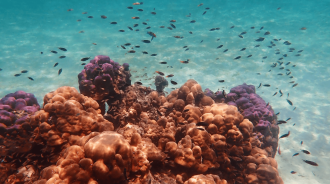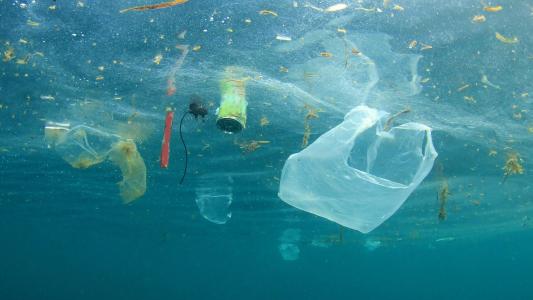Five hundred meters off Mexico’s Yucatán Peninsula, along the back-reef lagoon of the Mesoamerican Barrier Reef, there is a landscape marked by eroded limestone towers, sinkholes, and unique deep-sea groundwater springs.
The springs, called “ojos,” discharge acidic water, which rises in plumes from the seafloor. Here, researchers from the University of California Santa Cruz have found unique corals that thrives in future-like conditions expected because of climate change.
When marine biologist Adina Paytan was studying groundwater pollution in Mexico, ocean acidification was making headlines. The ocean, it turns out, is not the “carbon sink” it was once thought to be. As the seawater absorbs excess carbon from the air, it changes the ocean’s chemistry, becoming more acidic. The impact is far-reaching, especially for shallow-water habitats like coral reefs. It has sparked new efforts for coral reef restoration.
As Paytan dove through the waters of Puerto Morelos, off Mexico’s Yucatán Peninsula, she tried to imagine what the reefs might be like for future generations. Coral reefs are more than a pretty view: they provide a food source for local communities, support the tourism industry, act as a buffer against storm surges, and offer a home to a wide variety of marine life. Coral biologist Hollie Putnam, assistant professor at the University of Rhode Island, describes coral reefs as “a meta-organism … which can build a structure that’s so big it creates an ecosystem that can be seen from space.”
After a record-breaking heatwave in 2016, a third of the Great Barrier Reef experienced a massive die-off. The following year, it faced a bleaching event, which can lead to coral death, culminating in the loss of half the world’s largest reef system.
But time is running out for coral reefs just about everywhere. The primary threats to corals are warming and ocean acidification. At current trends, researchers estimate that by 2050, more than 90% of the world’s coral reefs will be massively degraded. Now, conservation researchers race to develop strategies for coral reef restoration and preservation.
Enter the humble stony coral — a supercoral in disguise.
Corals in the Wild: Can They Adapt to Climate Change?
About 500 meters from the coast, Paytan swam by clusters of stony corals. She saw three coral types: mustard coral, hump coral, and round starlet corals thriving in the acidic conditions near the submarine springs. She immediately saw the opportunity to study acidification in the field.
Scientists conducted most early ocean acidification studies in laboratory aquariums, where they could manipulate water conditions. Now researchers prefer to use real-world locations that are analogs of what’s expected when climate change takes a deeper hold.
“If you want to see if (corals) have a chance to adapt or live in the future, then you need to do the study in the natural environment, where they’re exposed to all of the other organisms and diseases, and so on,” Paytan says.
In Puerto Morelos, as rainwater passes through the soil, it absorbs carbon dioxide and increases in acidity before draining into the submarine springs. Paytan describes the plumes of acidic water that billow out of the springs as “more acidic than what we expect with ocean acidification.” And growing right alongside the acidic plumes are beautiful corals.
In a study published in Proceedings of the Royal Society, Paytan and her team transplanted corals between the springs and nearby reefs that were similar but did not have elevated acidity. She also brought in stony coral species that were foreign to that region. It turns out, this coral is resistant to the acidic conditions of a future where climate change wreaks havoc.
The Acid-Resistant Corals’ Secret Weapon
Paytan found that the relocated corals had a 70% survival rate — higher than she expected. When she took a closer look at their genetics, she expected to see a difference in the genes that control calcification, the process where corals build their rocky skeleton.
However, the important difference turned out to be in the genes that regulate metabolism. Rather than changing their calcification mechanism, the stony coral were changing their metabolism to be able to calcify despite the increased acidity.
Putnam, who did not participate in this study, says research like Paytan’s is better than lab experiments. “The only thing that would make it even a better study is if we had a time machine and could go into the future and study it,” Putnam says.
“The only thing that would make (this research better) is if we had a time machine and could go into the future and study it.”
Holli Putnam, assistant professor at the University of Rhode Island.
The acid-resistant stony corals aren’t perfect: with a compromised metabolism and weaker skeletons, they might not be able to overcome threats like a virus or storm surges. But Paytan sees a solution.
“Protect corals that can adapt and acclimatize from things we can control, like pollution, fishing, or invasive species,” Paytan urges. “It’s harder to strip CO2 from the atmosphere than to have laws that prevent sewage from flowing into the coast.”
Through selective breeding, scientists could cultivate adaptable supercorals that can withstand ocean acidification.
Putnam adds that if we can’t protect them all, then protecting more resilient corals could keep the reefs around longer. “This study gives us a better handle on who’s more robust and who’s more sensitive under potential future conditions, so that we can start thinking about what reefs of the future might look like and whether we’re going to protect certain areas.”
Paytan also sees an opportunity for creating a generation of corals that can withstand ocean acidification. Through selective breeding, scientists could cultivate adaptable corals, creating burlier species. Paytan calls it “assisted evolution.”
“We’re not really changing their genes, but we’re helping them do what would take longer in terms of evolution,” she says. She hopes her work will lead to targeted protection for sensitive areas and building resilient reefs, ready to withstand a harsh future.






